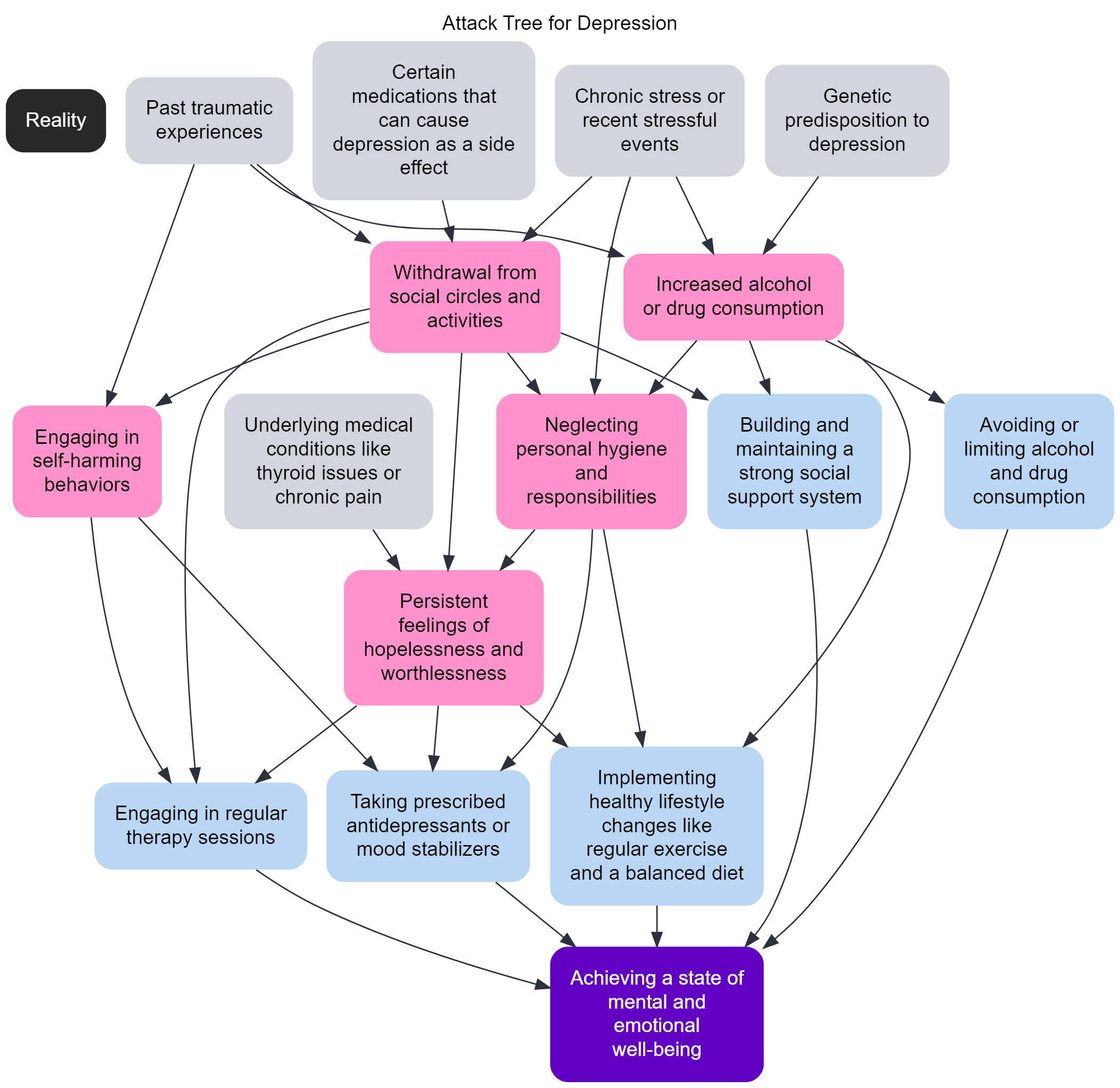Personally, the real triumph with applying mental health to a commonly known and used threat model is the value of seeing depression as part of a system that can be influenced. So many of us, weighed down by the sludge and fog of mental illness, know all too well feeling like there is no way out, no hope, and that nothing can be done to change it. Seeing depression as an outcome of a set of circumstances, leaves room for the belief that new circumstances, or at least a new combination of current or old circumstances, could change the outcome. New experiences. New tools. New communities. New chances for happiness.
One of the few diagrams used in threat modeling, attack trees have been a great tool for visualizing potential cybersecurity threats and vulnerabilities. These structured diagrams allow us to map out potential attack vectors, understand their root causes, and devise strategies to counteract them. But what if we took this concept, traditionally reserved for cybersecurity, and applied it to something deeply human and complex: mental health?
This week, I am going to treat depression like a threat and run it through this threat model, taking the concept one step further than I did in my recent blog Threat Modeling for Depression.
Understanding the Basics
Before diving deep, here are the foundational elements of an attack tree. At its core, an attack tree is composed of:
- Facts: These are the underlying truths or conditions that set the stage. In the context of depression, facts could be genetic predispositions, past traumas, or even certain medications.
- Attacks: Typically attacks refer to the types of cyber threats: phishing, malware, etc. For depression, attacks will represent it’s manifestations or symptoms and can include feelings of isolation, substance abuse, or persistent hopelessness.
- Mitigations: These are the countermeasures or strategies employed to address the attacks. In our analogy, mitigations could be therapy sessions, medication, or lifestyle changes.
- Goals: The end objective. For our attack tree on depression, the goal is achieving a state of mental and emotional well-being.
Visualizing depression through this structured approach has the potential to allow impacted individuals to see the interplay between causes, manifestations, and potential remedies. By laying out depression’s complexities in a clear, organized manner, we can better navigate its challenges and work towards holistic solutions. That’s my hope anyway.
Facts: The Underlying Causes
Depression, while often perceived as a singular entity, is a multifaceted condition with roots that dig deep into a myriad of causes. To truly understand its complexity, we must first explore the foundational truths that contribute to its onset:
- Genetic Predisposition: Just as we inherit physical traits from our family, we also inherit genetic codes that can make us more susceptible to depression. It’s not a guarantee, but having family members with depression can increase one’s risk.
- Past Traumatic Experiences: Traumatic events, whether in childhood or adulthood, can leave lasting scars on the psyche. Experiences like abuse, loss, or severe stress, can act as triggers, pushing individuals towards depressive states.
- Chronic Stress and Recent Events: Ongoing challenges, such as work-related stress, financial difficulties, or recent life-altering events like a breakup, can act as catalysts for depression.
- Medications and Side Effects: While medications are often designed to heal, they can sometimes have unintended consequences. Certain drugs, especially those related to hypertension or hormonal imbalances, can have depression as a side effect.
- Underlying Medical Conditions: Physical health and mental well-being are deeply intertwined. Conditions like thyroid issues, chronic pain, or even vitamin deficiencies can contribute to or exacerbate depressive symptoms.
Attacks: Manifestations of Depression
With the foundational causes laid out, it’s essential to recognize how depression manifests in daily life. These “attacks” on well-being can vary in intensity and form, but they all chip away at an individual’s quality of life:
- Isolation: One of the most common signs of depression is a withdrawal from social circles and activities. Triggered by factors like trauma, stress, or certain medications, isolation can further deepen feelings of loneliness and despair.
- Substance Abuse: To cope with overwhelming emotions, some turn to alcohol or drugs. While these substances might offer a temporary escape, they often exacerbate depressive symptoms in the long run. Stress, trauma, and even genetic factors can push individuals towards this path.
- Self-Harm: For some people, when depression overwhelms them, they turn to self harm or self injury for release. Self harm is simply put, anything that someone does to purposely hurt their body.
- Neglect: Depression can sap one’s energy and motivation, leading to neglect of personal hygiene, responsibilities, and even basic needs. This spiral of neglect can be triggered by isolation, substance abuse, or chronic stress.
- Hopelessness: Perhaps the most debilitating attack is an overwhelming sense of hopelessness. This feeling, often stemming from prolonged isolation or neglect, can make individuals feel trapped in their depressive state, unsure if they’ll ever find a way out.
Mitigations: Strategies to Counteract Depression
In the face of depression’s multifaceted attacks, it’s important to have a robust arsenal of mitigations. These proactive measures not only counteract the symptoms but also address the root causes, paving the way for recovery and resilience:
- Therapy: Engaging in regular therapy sessions provides a safe space for individuals to unpack their feelings, traumas, and fears. With the guidance of a trained professional, therapy can offer insights, coping mechanisms, and strategies to navigate the challenges of depression.
- Medication: For many, antidepressants or mood stabilizers play a crucial role in managing the chemical imbalances that contribute to depression. While not a one-size-fits-all solution, medication, when prescribed and monitored by a healthcare professional, can be a valuable tool in the fight against depression.
- Social Support: Human connection is a powerful antidote to feelings of isolation and despair. Building and maintaining a strong social support system—whether through family, friends, or support groups—can provide comfort, understanding, and a sense of belonging.
- Lifestyle Changes as a Holistic Approach: Beyond external support, internal changes can also bolster well-being. Regular exercise, a balanced diet, adequate sleep, and mindfulness practices like meditation can collectively uplift mood and provide a buffer against depressive symptoms.
- Avoiding or Limiting Substance Use: While substances might offer temporary relief, they often compound the challenges of depression. Recognizing and addressing substance abuse, and seeking help when needed, is vital for long-term recovery.
Goals: The Path to Wellness
At the heart of all these mitigations lies a singular, overarching aim: achieving a state of mental and emotional well-being. This goal isn’t about the absence of challenges but rather the presence of tools, strategies, and support to navigate them:
- Achieving Mental and Emotional Well-being: Mental health is a journey, not a destination. It’s about finding balance, understanding oneself, and having the resilience to face life’s ups and downs. It’s a state where challenges are acknowledged, but they don’t define one’s existence.
- The Collective Power of Mitigations: Each mitigation—therapy, medication, social support, lifestyle changes, and more—plays a unique role in the journey to wellness. Together, they form a comprehensive strategy, addressing the nuance of depression and ensuring that individuals have a multi-pronged approach to recovery.
The Attack Tree: Power of Visualization
In a world saturated with information, the ability to visualize complex concepts can be a game-changer. The attack tree offers a fresh lens to view and understand the intricacies of depression, maybe especially for us security nerds who are all too familiar with mental health challenges:
- Benefits of the Attack Tree: By breaking down depression into its foundational facts, manifestations, and potential mitigations, the attack tree threat model provides clarity amidst complexity. It allows for a structured exploration of depression, making it easier to identify patterns, triggers, and potential solutions.
- Visualizing the Interplay: The true power of this approach lies in its ability to showcase the dynamic interplay between facts, attacks, and mitigations. By visually mapping out these elements, individuals, caregivers, and professionals can make more informed decisions, tailor strategies to specific needs, and anticipate potential challenges.
Call to Action
The challenge for you today, if you struggle with mental health issues and depression specifically, is to make this tree personal. Put your story and experiences into it. Write it down. Connect the dots. Look at the whole picture and find the places where you DO have control. Please do this with a bevy of social and professional supports in place. Going deep is not always comfortable and you deserve to be supported through whatever comes up for you.
I like Kelly Shortridge and Ryan Petrich’s tool - deciduous.app - for this. If you do make one and feel like sharing with me, I’d love to see it. Write me on twitter - @mattjay.
Your insights and experiences are invaluable. How do you perceive the attack tree approach for depression? Are there elements you’d add, modify, or approach differently? Would you like to see more threat models?
Let’s foster a community of understanding and support. Let’s get vulnerable and build a more resiliant community of tomorrow.





